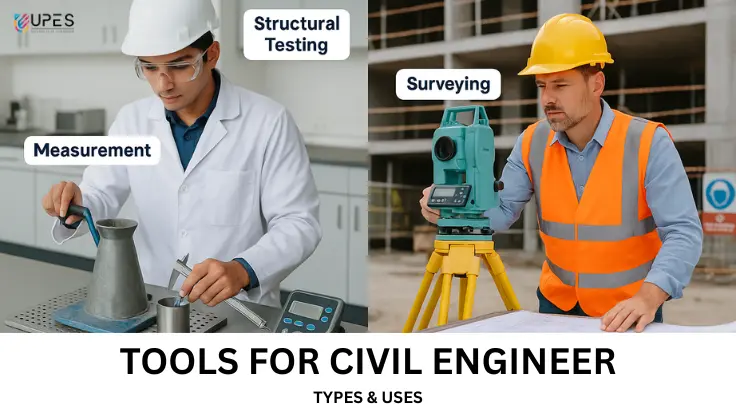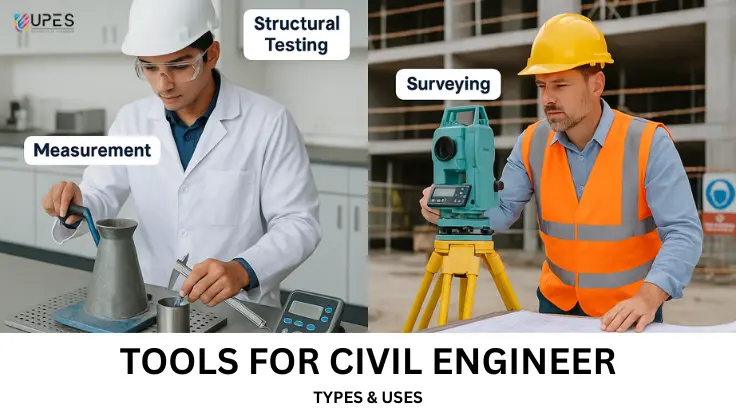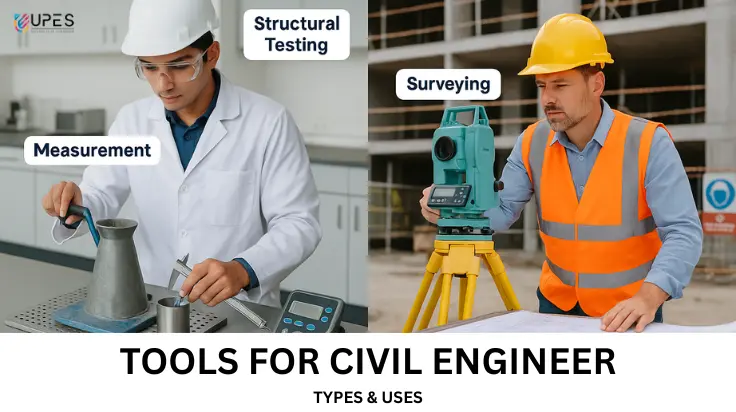Explore essential Civil Engineering tools, their classifications, & how they're used in real-world construction and infrastructure projects.

Table of Contents:
Civil engineering, one of the oldest and most dynamic branches of engineering, relies heavily on precision, planning, and the right equipment. Whether it's laying the foundation of a smart city or constructing a flood-resistant bridge, the accuracy and quality of civil engineering projects are shaped by the tools for civil engineers.
In this blog, we explore the essential civil engineering tools, their classifications, and how they're used in real-world construction and infrastructure projects.
Why Tools Matter in Civil Engineering
The success of any civil engineering project—be it surveying land or curing concrete—rests not just on design and materials, but on the correct usage of civil engineering equipment. The right instruments ensure safety, cost-efficiency, and compliance with technical standards. As civil engineers move toward more sustainable and smart infrastructure, their reliance on modern civil engineer tools continues to grow.
This becomes even more critical in a rapidly evolving profession. As highlighted in the broader future of civil engineering, modern construction demands professionals who are proficient in both traditional and smart technologies.
Types of Civil Engineering Tools and Instruments
Civil engineering tools can be broadly categorized into:
- Surveying Instruments
- Construction Tools
- Material Testing Instruments
- Safety Equipment
- Digital and Smart Tools
Each category plays a critical role in different phases of a civil project—from planning to completion.
1. Surveying Civil Engineering Instruments
Purpose: Measurement, alignment, and site planning
Surveying tools form the backbone of any infrastructure project. These surveying civil engineering instruments help engineers determine land elevations, boundaries, and gradients.
Common Tools:
- Theodolite: Measures horizontal and vertical angles with high precision
- Total Station: Combines electronic distance measurement and angle measurement
- Auto Level: Used for precise leveling
- Measuring Wheel: Measures distance on the ground quickly and efficiently
Where to Use: Site planning, road construction, bridge design, urban infrastructure
2. Construction Tools for Civil Engineers
Purpose: On-site construction tasks like mixing, lifting, digging, and plastering
Basic tools are essential for execution. These civil engineering tools are usually handheld but critical to the success of fieldwork.
Common Tools:
- Trowel: For finishing mortar or plaster
- Concrete Mixer: Combines cement, sand, gravel, and water
- Wheelbarrow: Transports materials on site
- Jackhammer: Breaks concrete or pavement
Where to Use: Concrete casting, roadwork, wall construction, slab finishing
3. Material Testing Equipment in Civil Engineering
Purpose: Assessing strength, durability, and compliance of construction materials
Material testing is vital for ensuring project longevity and structural integrity. These civil engineering instruments help identify defects and confirm quality.
Common Equipment:
- Compression Testing Machine (CTM): Tests strength of concrete cubes or cylinders
- Slump Cone: Measures workability of fresh concrete
- Sieve Shaker: Determines aggregate grading
- Ultrasonic Pulse Velocity Tester: Assesses concrete homogeneity
Where to Use: Quality control labs, R&D facilities, on-site concrete assessment
For a deeper understanding of how these tools contribute to modern infrastructure, explore the scope of civil engineering in the Indian and global context.
4. Safety and Protective Equipment
Purpose: Worker safety and compliance
Safety is paramount in civil projects, especially in high-risk areas like high-rise buildings or highways. Hence, civil engineering equipment isn't limited to tools that shape concrete but also includes equipment that safeguards lives.
Common Safety Gear:
- Hard Hats: Protect against falling debris
- High-Visibility Vests: Ensure worker visibility
- Safety Harnesses: Used in high-altitude construction
- Dust Masks & Ear Protection: Mitigate exposure to pollutants and loud machinery
Where to Use: All construction and survey sites
To better understand related fields, consider reading about the key differences between electrical and electronics engineering, especially if your interests lie in digital systems or communication technologies.
5. Digital Tools and Smart Instruments
Purpose: Automation, data analytics, and design precision
Digital transformation has ushered in a new era in civil engineering. These civil engineering equipments use software and sensors to automate routine work and improve decision-making.
Popular Tools:
- Drones: For aerial surveys and real-time site inspections
- GPS Devices: For accurate geolocation data
- BIM Software (e.g., Revit, AutoCAD Civil 3D): For collaborative design and modeling
- Laser Scanners: For creating 3D models of terrain and structures
Where to Use: Urban planning, smart cities, large infrastructure projects, pre-construction surveys.
Using the Right Tools
From surveying civil engineering instruments to advanced BIM tools, the diversity of tools for civil engineers reflects the complexity of the profession. Each tool has a distinct function but together they help civil engineers build resilient, safe, and future-ready infrastructure.
As the demand for skilled engineers grows, understanding when and how to use these civil engineering instruments becomes a critical part of professional training. At institutions like UPES School of Advanced Engineering, students receive hands-on training with both traditional and smart tools, bridging academic learning with industry readiness.
By staying updated with these essential tools and their applications, aspiring civil engineers can ensure they are not just job-ready, but future-ready.





